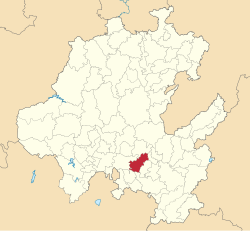Pachuca Municipality
Pachuca | |
|---|---|
 | |
| Country | Mexico |
| State | Hidalgo |
| Municipal seat | Pachuca de Soto |
| Government | |
| • Municipal President | Eleazar García Sánchez |
| Population | |
| • Total | 267 862[1] |
| Time zone | UTC-6 (CST) |
| • Summer (DST) | UTC-5 (CDT) |
The Municipality of Pachuca de Soto, or Municipality of Pachuca, is one of the Municipalities of the state of Hidalgo, located in east-central Mexico.
The municipal seat is the City of Pachuca de Soto (Ciudad de Pachuca de Soto). The Municipality of Pachuca is increasingly co-extensive with the metropolitan area of Pachuca, as development has grown to cover over 60% of the geographic open space. That has eliminated much of the municipality's native flora diversity and larger fauna.
Geography
[edit]

in the Municipality of Pachuca.
The location of the municipality is north of the state of Mexico, and is located in the low extreme geographical coordinates of Greenwich, north latitude 20º01'23", 20º12'28" maximum, west longitude 98°41'30" minimum, 98°52'35" maximum.[2] The Municipality of Pachuca has a territory of 195,300 square kilometres (75,400 sq mi) and borders the municipalities of Mineral del Chico, Mineral del Monte, Zempoala, Zapotlán de Juárez, Mineral de la Reforma, Epazoyucan, and San Agustín Tlaxiaca.
Natural features
[edit]The municipality is located in rugged hill and mountain terrains, and varies in altitude between 2,400–2,800 metres (7,900–9,200 ft) above sea level.[3][4] It is located on the Trans-Mexican Volcanic Belt (Eje Volcánico Transversal, Sierra Nevada) mountain ranges system. The only major level terrain is where the historic center of Pachuca city is located. Notable mountains are the Cerro del Cuixi, the Cerro de San Cristóbal, and the Cerro de Cubitos.
Rivers that cross through the municipality are the Actopan, the Amajac and the Tezontepec Rivers. The climate is temperate and relatively cold with strong winds during eight to nine months out of the year. These can reach speeds of 60–65 km an hour.[4]
Economy
[edit]64% of the Municipality of Pachuca is a developed urban area. Agriculture is nearly a non-existent factor in the economy, as the small-scale farming and livestock raising in the hills is for family or local consumption.[citation needed]
Industry
[edit]Despite its decline in the 20th century, mining still continues to be an important element of Pachuca's economy. Pachuca still produces more than 60% of the state's gold and more than 50% of its silver.
The manufacturing sector was established in the 1950s and has been steadily growing, changing the city's traditional mining image. Some of the major industrial employers are Applied Power de México (automotive parts), BARROMEX (machinery), Herramientas Cleveland (machinery and tools) and Embotelladora la Minera (soft drinks). The city also contains over 800 smaller manufacturing enterprises.
The municipality's economy also has a large commercial sector, with numerous stores and thirteen public markets. It is also the wholesale center for foodstuffs for most of the state.
Tourism
[edit]Despite all the changes in the 20th century, the Historic center of Pachuca has maintained its colonial provincial feel. This has led the municipality and city to promote it as a tourist attraction.[4][5]
The Mina de Acosta is a mine, and an open-air and subterranean mining museum, adjacent to Pachuca in the village of Real del Monte in the municipality. It is still active, but barely as for each ton and a half of ore extracted, only 200 grams of silver and 2 grams of gold are obtained. Guided tours show how ore is extracted from the mine, at depths up to 500 metres (1,600 ft).
Politics
[edit]Demography
[edit]According to the 2005 census the Municipality of Pachuca de Soto had 275,578 inhabitants. The municipality contains fifteen other communities, with all but two having less than 1,500 people according to the 2005 INEGI census.
Only three percent of the municipality's population lives outside the Pachuca city boundaries.[3] The majority of the residents are Roman Catholic, but there is a significant percentage of Protestants, mostly descendants of English miners.[4]
Populated places in Pachuca
[edit]| Town | Population |
| Total | 267,862[6] |
| Pachuca de Soto | 256,584 |
| Santiago Tlapacoya | 3362 |
| San Miguel Cerezo | 1981 |
| El Huixmí | 2567 |
Settlements in the Municipality of Pachuca include:
- Barrio del Judío
- La Rabia
- El Comal
- El Bordo (Barrio del Bordo)
See also
[edit]References
[edit]- ^ Pachuca municipality SEDESOL, Catálogo de localidades.
- ^ INEGI (2009). "Link to tables of population data from Census of 2009 INEGI: Instituto Nacional de Estadística, Geografía e Informática" (PDF). Archived from the original (PDF) on 2016-09-23.
- ^ a b "Principales resultados por localidad 2005 (ITER)". INEGI. Archived from the original on 2011-07-22. Retrieved 2009-10-08.
- ^ a b c d "Estado de Hidalgo Pachuca de Soto" (in Spanish). Enciclopedia de los Municipios de México. Archived from the original on 2011-05-17. Retrieved 2009-10-08.
- ^ "Fundación, historia y desarrollo de Pachuca" [The founding, history and development of Pachuca] (in Spanish). Mexico City: El Clima. Retrieved 2009-10-08.
- ^ Pachuca municipality SEDESOL, Catálogo de localidades.

